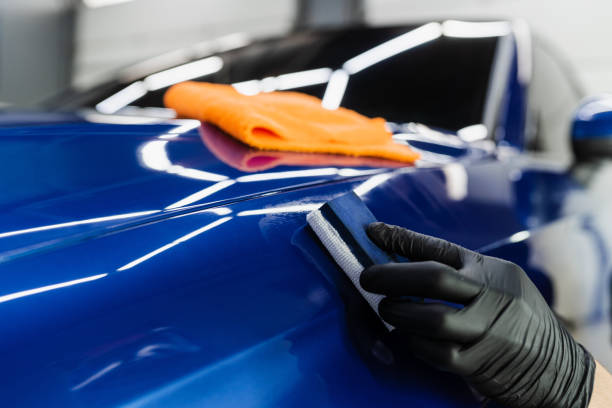High-End Auto Detailing at Conforti Auto and Marine Detailing Ceramic Coating
High-End Auto Detailing at Conforti Auto and Marine Detailing Ceramic Coating
Blog Article
Exactly How Outlining Ceramic Covering Improves the Durability of Your Auto's Paint
Ceramic layer has emerged as a critical technology in auto outlining, offering a durable option for preserving the honesty of your cars and truck's paint. Comprehending the intricacies of just how ceramic coating works and its benefits over typical wax can supply useful insights for auto proprietors.
What Is Ceramic Coating?
Comprehending the safety advantages of ceramic covering starts with identifying its make-up and performance. Ceramic coating is a fluid polymer related to the outside surface areas of automobiles, largely designed to boost and secure auto paint. The crucial component of this finish is silicon dioxide (SiO2), which is originated from natural products like sand. This compound creates a strong chemical bond with the manufacturing facility paint, creating a protective layer that is both long lasting and hydrophobic.
The finishing's application involves thorough prep work of the automobile's surface, which need to be without contaminants, scrapes, and imperfections to guarantee ideal attachment. Once applied, the ceramic finishing cures to create a rigid guard that can endure numerous ecological elements, consisting of UV rays, chemical discolorations, and oxidation.
In addition, ceramic finishes are not merely surface-level treatments; they pass through the paint to provide a long-term protection. This performance prolongs the life-span of the lorry's appearances while preserving its worth gradually. Understanding these fundamental facets of ceramic coating is important for car owners looking for reliable solutions for paint preservation and enhancement.
Benefits of Ceramic Covering
The advantages of ceramic finishing expand much beyond its standard protective features - Conforti Auto and Marine Detailing Ceramic Coating. One of one of the most substantial benefits is its capacity to offer phenomenal longevity. Unlike typical wax or sealers, ceramic layers develop a solid bond with the automobile's paint, permitting it to endure environmental risks such as UV rays, acid rainfall, and road salt. This resilience significantly reduces the danger of paint damages, protecting the automobile's aesthetic charm.
Furthermore, ceramic finishes offer hydrophobic residential or commercial properties, suggesting they drive away water and pollutants. This particular not only makes the car less complicated to clean but also minimizes the regularity of cleaning, conserving both effort and time for automobile proprietors. The glossy surface area developed by the coating avoids dirt and gunk from sticking, improving the vehicle's overall sanitation.
Furthermore, ceramic layers enhance the deepness and quality of the paint, providing cars a glossy finish that is visually striking. This visual enhancement further contributes to keeping the automobile's resale worth, as a properly maintained exterior is a significant selling point for potential purchasers. In general, the benefits of ceramic finish make it a beneficial investment for anyone wanting to safeguard and improve their lorry's paintwork.
Exactly How Ceramic Layer Works

The layer's hydrophobic homes repel water and dust, preventing the accumulation of crud on the surface. This not just makes the auto easier to clean yet additionally minimizes the probability of scratches and swirl marks brought on by conventional washing approaches. The ceramic layer acts as a guard versus UV rays, which can create fading and oxidation over time.
Once cured, the covering displays impressive resistance to chemicals, consisting of roadway salts, bird droppings, and tree sap, which can or else damage the paint. The longevity of ceramic finishes can last for several years, relying on variables such as upkeep and ecological conditions. Overall, the chemical bonding procedure of ceramic coverings gives a robust defense that preserves the honesty and appearance of an automobile's paintwork.
Comparing Ceramic Covering to Wax
Contrasting ceramic layer to conventional wax discloses significant differences in performance and longevity. While both products aim to shield a car's paint, their compositions and durability established them apart. Wax, commonly made from natural carnauba or synthetic materials, offers a my sources momentary guard Homepage that usually lasts just a couple of weeks to a few months, depending upon environmental conditions and upkeep regimens.
In contrast, ceramic layers are advanced solutions composed of inorganic materials that bond chemically with the lorry's paint. This develops a durable, semi-permanent layer of security that can endure for a number of years. Therefore, ceramic layers supply superior resistance to UV rays, chemical spots, and physical abrasion, considerably minimizing the danger of oxidation and fading.
Furthermore, the hydrophobic residential properties of ceramic coatings make certain that water grains up and rolls off the surface area, making it a lot more hard for dust and gunk to adhere. This convenience of cleaning is a notable benefit over wax, which can draw in dirt and call for regular reapplication. Inevitably, for auto proprietors seeking resilient protection and improved visual appeal, ceramic finishings provide an extra reliable choice to conventional wax items.
Upkeep Tips for Longevity
Correct upkeep is important for taking full advantage of the long life of a ceramic finishing. Utilize a pH-balanced auto shampoo to avoid degrading the finish, and avoid automatic vehicle washes with harsh brushes that can cause micro-scratches.
To maintain the hydrophobic residential properties of the ceramic covering, think about using an upkeep spray or booster particularly developed for ceramic coverings every few months. This will reinforce the protective layer and enhance water beading.
Additionally, avoid exposing the coated surface to severe environmental conditions whenever possible. Car parking in shaded locations or using a vehicle cover can protect against UV damages and contamination from bird droppings, tree sap, or industrial after effects.
Last but not least, inspect the layer regularly for indicators of wear or damages. If you notice a reduction in hydrophobic behavior, it may be time for a professional reapplication. By adhering to these maintenance pointers, automobile proprietors can substantially extend the life and efficiency of their ceramic finish, ensuring that their vehicle's paint remains protected and aesthetically appealing for several years to come.
Verdict

Report this page